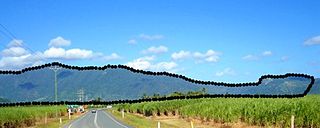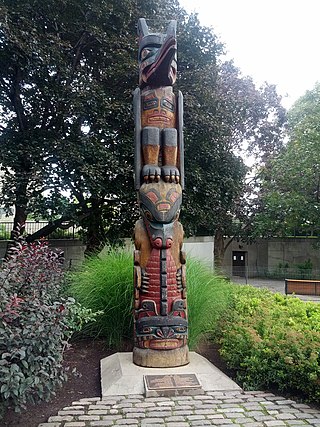
Australian Aboriginal religion and mythology is the sacred spirituality represented in the stories performed by Aboriginal Australians within each of the language groups across Australia in their ceremonies. Aboriginal spirituality includes the Dreamtime, songlines, and Aboriginal oral literature.

The Dreaming, also referred to as Dreamtime, is a term devised by early anthropologists to refer to a religio-cultural worldview attributed to Australian Aboriginal beliefs. It was originally used by Francis Gillen, quickly adopted by his colleague Baldwin Spencer and thereafter popularised by A. P. Elkin, who, however, later revised his views.
In Binbinga mythology, Ulanji is a snake-ancestor of the Binbinga. He bit the heads off some flying foxes and took out two of their ribs and their heart. Ulanji emerged from the ground at a place called Markumundana. He walked along to a large hill, Windilumba, where he made a spring, and also a mountain close by. He crossed what is now known as the Limmen Creek, and made a range of hills and a valley, with a large number of water-holes and plenty of lilies in them. He left behind numbers of Ulanji spirits, which emanated from his body, wherever he performed ceremonies. After travelling over a great extent of country, and making many mungai spots, he finally went into the ground at a water-hole called Uminiwura.
In the mythology of the Wunambal people of northwestern Australia, Ungud is a snake god who is sometimes male, sometimes female and sometimes androgynous. He is associated with rainbows by the fact Ungud may be an symbolic representation of rainbows and the fertility and erections of the tribe's shamans. In the beginning, when only the sky and the earth existed, Ungud lived underground as a giant python. Ungud is associated with earth and water and is credited with causing rain to fall and also has connections with monsoons. At night, Ungud and Wallanganda, the sky deity, created living beings through their dreams. The Mother Goddess Kunapipi who is also at times is called the Old Woman is connected to Ungud. The Rainbow Serpent made paths for her to walk around creation. Both The mother goddess and Rainbow serpent are the embodiment of creative powers that live within the earth. Through Ungud Dreaming itself into new forms natural species making it part of what life is based on becoming an archetype of life.
The Wawalag sisters, also written as WauwalukWawilakWaggilak, Wagilag, or Wawalik, are ancestral creator beings whose story is part of widespread sacred rituals in the Aboriginal culture from Arnhem land, Northern Territory, Australia.

A totem is a spirit being, sacred object, or symbol that serves as an emblem of a group of people, such as a family, clan, lineage, or tribe, such as in the Anishinaabe clan system.
In the mythology of the Western and Central Torres Strait Islanders, Kibukuth "Horizon's End" is the mythical land of the ancestoral spirits and the awgadhal "totemic gods", believed to exist beyond the sky dome (dapar) surrounding the world, with its main entrance over the horizon far to the west.

The Rainbow Serpent or Rainbow Snake is a common deity often seen as the creator God, known by numerous names in different Australian Aboriginal languages by the many different Aboriginal peoples. It is a common motif in the art and religion of many Aboriginal Australian peoples. Much like the archetypal mother goddess, the Rainbow Serpent creates land and diversity for the Aboriginal people, but when disturbed can bring great chaos.

The Peramangk are an Aboriginal Australian people whose lands traditionally comprise the Adelaide Hills, as well as lands to the west of the Murray River in mid Murraylands and through to the northern part of the Fleurieu Peninsula in the Australian state of South Australia.

The Murrinh-Patha, or Murinbata, are an Aboriginal Australian people of the Northern Territory.

The Wagyl is the Noongar manifestation of the Rainbow Serpent in Australian Aboriginal mythology, from the culture based around the south-west of Western Australia. The Noongar describe the Wagyl as a snakelike Dreaming creature responsible for the creation of the Swan and Canning rivers and other waterways and landforms around present day Perth and the south-west of Western Australia.
This article gives an overview of Australian Aboriginal kinship groupings within Western Australia, with the tribal boundaries based on Norman Tindale's 1974 map, as published in Western Australia: An Atlas of Human Endeavour (1979) by the Government of Western Australia.

In Australian Aboriginal religion and mythology, Crow is a trickster, culture hero and ancestral being. In the Kulin nation in central Victoria he is known as Waang and is regarded as one of two moiety ancestors, the other being the more sombre eaglehawk Bunjil. Legends relating to Crow have been observed in various Aboriginal language groups and cultures across Australia.
The Wik-Mungkan people are an Aboriginal Australian group of peoples who traditionally ranged over an extensive area of the western Cape York Peninsula in northern Queensland and speak the Wik Mungkan language. They were the largest branch of the Wik people.
The Maraura or Marrawarra people are an Aboriginal group whose traditional lands are located in Far West New South Wales and South Australia, Australia.
The Bininj are an Aboriginal Australian people of Western Arnhem land in the Northern Territory. The sub-groups of Bininj are sometimes referred to by the various language dialects spoken in the region, that is, the group of dialects known as Bininj Kunwok; so the people may be named the Kunwinjku, Kuninjku, Kundjeyhmi (Gundjeihmi), Manyallaluk Mayali, Kundedjnjenghmi and Kune groups.
The Ngugi are an Aboriginal Australian people, one of three Quandamooka peoples, and the traditional inhabitants of Moreton Island.
The Yetimarala, also written Jetimarala and Yetimarla and also known as Bayali, Darumbal, Yaamba and other names and variant spellings, were an Aboriginal Australian people of eastern Queensland.
Mick Kubarkku (c.1922-2008) was regarded as a prominent Aboriginal Australian artist most associated with Kuninjku modernism.








